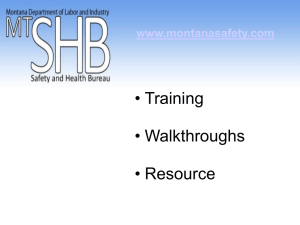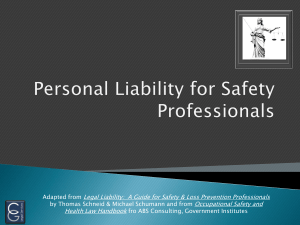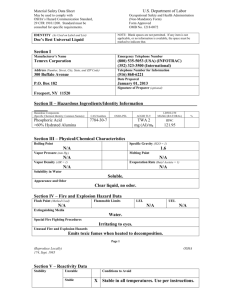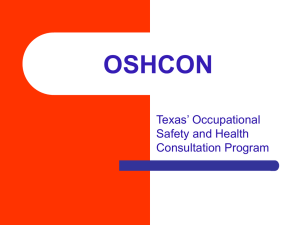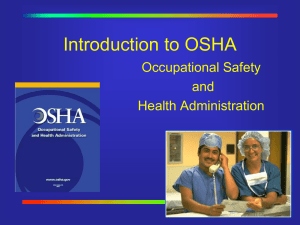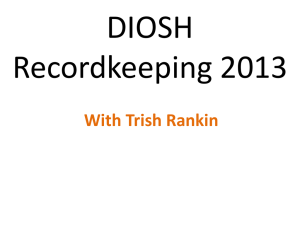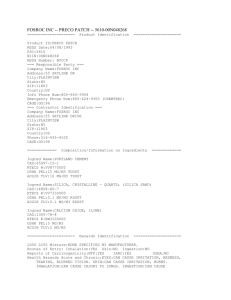Management Level Heat Stress Lesson Plan
advertisement
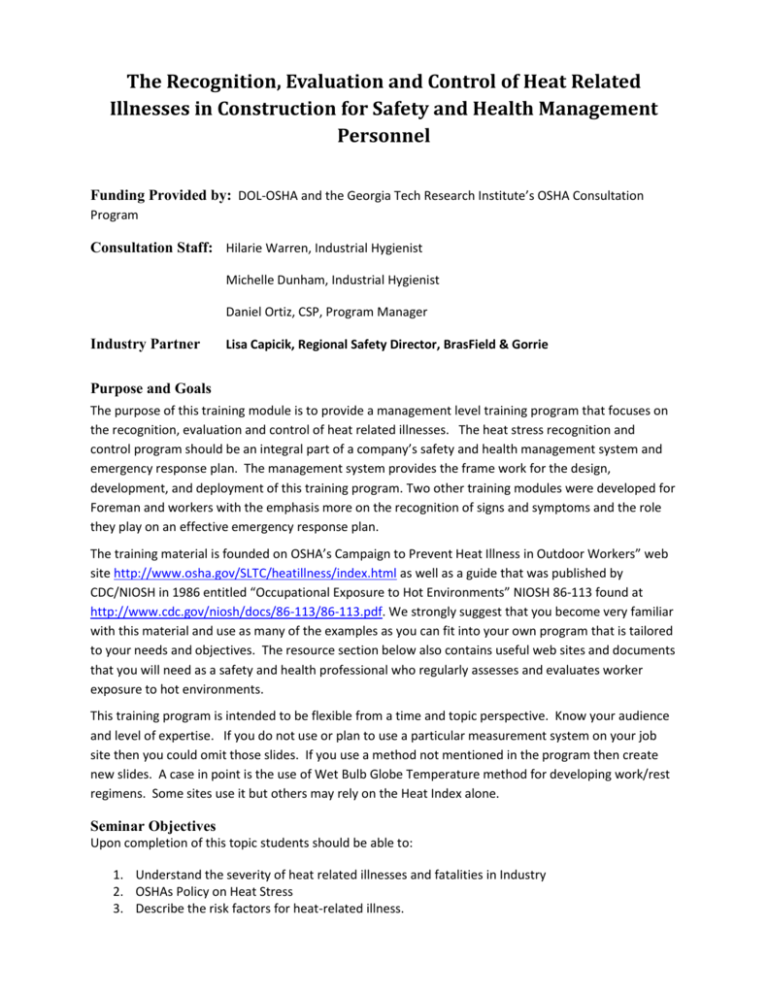
The Recognition, Evaluation and Control of Heat Related Illnesses in Construction for Safety and Health Management Personnel Funding Provided by: DOL-OSHA and the Georgia Tech Research Institute’s OSHA Consultation Program Consultation Staff: Hilarie Warren, Industrial Hygienist Michelle Dunham, Industrial Hygienist Daniel Ortiz, CSP, Program Manager Industry Partner Lisa Capicik, Regional Safety Director, BrasField & Gorrie Purpose and Goals The purpose of this training module is to provide a management level training program that focuses on the recognition, evaluation and control of heat related illnesses. The heat stress recognition and control program should be an integral part of a company’s safety and health management system and emergency response plan. The management system provides the frame work for the design, development, and deployment of this training program. Two other training modules were developed for Foreman and workers with the emphasis more on the recognition of signs and symptoms and the role they play on an effective emergency response plan. The training material is founded on OSHA’s Campaign to Prevent Heat Illness in Outdoor Workers” web site http://www.osha.gov/SLTC/heatillness/index.html as well as a guide that was published by CDC/NIOSH in 1986 entitled “Occupational Exposure to Hot Environments” NIOSH 86-113 found at http://www.cdc.gov/niosh/docs/86-113/86-113.pdf. We strongly suggest that you become very familiar with this material and use as many of the examples as you can fit into your own program that is tailored to your needs and objectives. The resource section below also contains useful web sites and documents that you will need as a safety and health professional who regularly assesses and evaluates worker exposure to hot environments. This training program is intended to be flexible from a time and topic perspective. Know your audience and level of expertise. If you do not use or plan to use a particular measurement system on your job site then you could omit those slides. If you use a method not mentioned in the program then create new slides. A case in point is the use of Wet Bulb Globe Temperature method for developing work/rest regimens. Some sites use it but others may rely on the Heat Index alone. Seminar Objectives Upon completion of this topic students should be able to: 1. Understand the severity of heat related illnesses and fatalities in Industry 2. OSHAs Policy on Heat Stress 3. Describe the risk factors for heat-related illness. 4. Describe the different types of heat-related illness, including how to recognize common signs and symptoms and basic first aid 5. Describe the common control practices and methods to reduce the risk of heat related worker illnesses and injuries. 6. Describe assessment tools used on the job site 7. Discuss the importance of acclimatization, how it is developed, and how your worksite procedures address it. 8. Describe the procedures for responding to possible heat-related illness through an effective safety and health management system. Course Topics Defining the Problem: History and OSHA Enforcement Recognition of Heat Related Illnesses Prevention and Control of Heat Related Illnesses Measurement and Evaluation of Risk Factors Associated with Heat Related Disorders Safety and Health Management System Integration Training Resources a. b. c. d. e. f. PowerPoint Presentation with instructor notes (Black and White) LCD Projector and/or flip chart/white board OSHA Guide for Employers Carry Out Heat Safety Training for Workers Web sites (if available) Exercise Handouts FACE and Miscellaneous Materials Folder Activities and Classroom Procedures 1. Training Techniques a. Lecture: Present materials on PowerPoint slides b. Browse web sites c. Directed discussion: student involvement with different management systems Lesson Roadmap 1. The Importance of Heat Stress Illness and Fatality Prevention in Industry a. Slides to be used : 3-10 b. Objectives covered : 1 c. Exercise/demos : Video Clip Example Slide 11 d. Training aids : Video clip 2. OSHA Enforcement a. Slides to be used : 11-13 b. Objectives covered : 2 c. Exercise/demos : None d. Training aids : None 3. Recognition of Risk Factors Associated with Heat Related Illnesses a. Slides to be used : 14-21 b. Objectives covered : 3,4 c. Exercise/demos : None d. Training aids : None 4. Heat Related Illnesses a. Slides to be used : 22-39 b. Objectives covered : 5 c. Exercise/demos : None d. Training aids : None 5. Control of Risk Factors Associated with Heat Related Illnesses a. Slides to be used: 40-56 b. Objectives covered: 5 c. Exercise/demos: Planning Ahead for Hot Weather, have individuals or groups create a planning document (optional) d. Training aids: None 6. Measurement and Evaluation of Heat Stress a. Slides to be used : 57-79 and optional 113 and 114 b. Objectives covered : 6 c. Exercise/demos : Task Analysis Exercise: What is important to include in the JSA from a heat stress control standpoint d. Training aids: Facilitated discussion. 7. Safety and Health Management System a. Slide to be used: 80 b. Objectives covered: 8 c. Exercise/Demos: Discussion with participants on elements of an effective system. Demonstrate “Safety Pays” for Heat Stress d. Training aids: Facilitated Discussion on elements OSHA e-Tool and OSHA Safety Pays 8. Heat Stress Job Site Case Study on Work Load, HI, and WBGT(Optional) a. Slides to be used : 81-101 b. Objectives covered : all c. Exercise/demos : Task Analysis and Heat Measurement Exercises d. Training aids: Facilitated discussion, work shop based on examples in slides and notes 9. Fatality Assessment and Control Evaluation Case Study (Optional) a. Slides to be used : 102-105 b. Objectives covered : all c. Exercise/demos : Construction Heat Stress Fatality Case d. Training aids: Facilitated discussion of case study slides 10. OSHA Resources, Summary, Quiz and Questions a. Slides to be used : 106-112 and 3 b. Objectives covered : all c. Exercise/demos : Quiz Slide 3, OSHA Heat Illness Prevention web site demo. d. Training aids: Facilitated discussion, Quiz and wrap up Evaluation and Assessment a. Interactive conversations b. Quiz from Slide 3 Before and After Resources ACGIH Heat Stress and Strain: TLVs Physical Agents 7th Edition Documentation http://www.acgih.org/store/ProductDetail.cfm?id=1361 AMERICAN JOURNAL OF INDUSTRIAL MEDICINE 50:940–950 (2007) Occupational Heat Illness in Washington State, (provided in “FACE and Miscellaneous Materials” folder) CDC Extreme Heat Prevention Guide http://emergency.cdc.gov/disasters/extremeheat/heat_guide.asp CDC NIOSH 86-113 Occupational Exposures to Hot Environments http://www.cdc.gov/niosh/docs/86-113/86-113.pdf OSHA: A Guide for Employers to Carry-out Heat Safety Training for Workers http://www.osha.gov/SLTC/heatillness/osha_heattraining_guide_0411.pdf OSHA Heat Illness Occurrence Map http://www.osha.gov/SLTC/heatillness/map_text.html OSHA HAZWOPER Standard 29 CFR 1910.120(g)(5)(x) addresses PPE and Heat Stress. OSHA Accident Search Engine http://www.osha.gov/pls/imis/accidentsearch.html OSHA Water Rest and Shade http://www.osha.gov/SLTC/heatillness/index.html OSHA’s Safety and Health Management System e-Tool https://www.osha.gov/SLTC/etools/safetyhealth/index.html OSHA’s Safety Pays Program https://www.osha.gov/dcsp/smallbusiness/safetypays/index.html OSHA Technical Guide on Heat Stress http://www.osha.gov/dts/osta/otm/otm_iii/otm_iii_4.html#4 CDC Extreme Heat Prevention Guide http://emergency.cdc.gov/disasters/extremeheat/heat_guide.asp CDC NIOSH 86-113 Occupational Exposures to Hot Environments http://www.cdc.gov/niosh/docs/86-113/86-113.pdf Relevant ISO Documents Purchase ISO Publications from: http://webstore.ansi.org/?source=msn&adgroup=standards&keyword=iso%20standards ISO 7243 WBGT Measurement ISO 7933 Analytical Interpretation of Heat Stress ISO 12894 Medical Supervision ISO 8996-2004 Ergonomics of Thermal Environment- Determination of Metabolic Rate Thomas E. Bernard, Ph.D., USF, Basic Tools, Screening, and Analysis (free) http://personal.health.usf.edu/tbernard/thermal/index.html Thomas E. Bernard, Ph.D., ACGIH Chairman Heat Stress Update Presentation http://www.acgih.org/tlv/04_TLV-PA-Update_AIHce06.pdf A Guide to Preventing Heat Stress and Cold Stress pages 17-18. North Carolina DOL-OSHA. Also found in “FACE and Miscellaneous Materials” Folder http://www.nclabor.com/osha/etta/indguide/ig35.pdf Dept of Army and Air Force, March 2003, Chapter 3 Heat Stress Management Tables 3.1 and 3.3 from TB Med 507/AFPAM 48-152(I) Heat Stress Control and Heat Casualty Management Navy OSH Heat Stress Program Presentation http://view.officeapps.live.com/op/view.aspx?src=http%3A%2F%2Fwww.med.navy.mil%2FDocu ments%2FNaval%2520Aviation%2520Survival%2520Training%2520Program%2520SME%2520W ebsite%2Flibrary%2FNAVOSH_heat%2520stress.ppt
